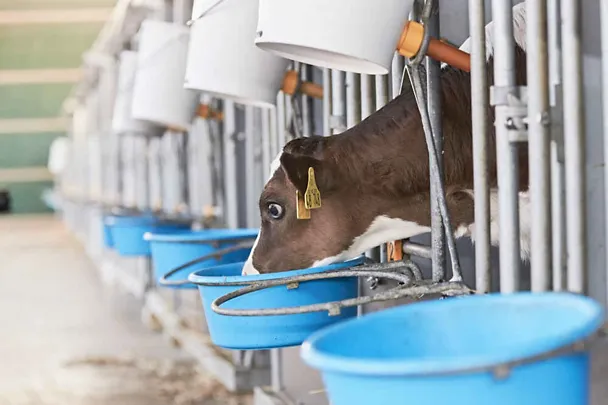Feeding calves correctly: Don’t forget the rumen

The basis for a high yield potential of heifers, milk cows and fattening bulls is laid as early as in the calf barn. Here, the focus is often on the drinking intensity. However, with all the positive effects of intensive drinking, the development of the rumen must not be overlooked. Starting at the 3rd week of life, the energy and protein needs of calves increases beyond the values provided by drinking mixes of 1 kg milk replacer per animal per day.
Long hay as calf feed is not enough
While in the past one supplemented liquid feed with long hay, today it is known that because of the still minimally developed rumen, the calf can absorb insufficient nutrients from the hay. At the same time, the rumen does not develop as quickly with rations of milk and hay as when using concentrated feed. Over the course of time, numerous studies have shown that concentrated feed promotes rumen development. Above all the chemical stimulus of butyrate and propionate caused by concentrated feed stimulates the growth of the ruminal papillae.
Dry TMR for calves ensures sufficient feeding and rumen health
Despite the positive effect of concentrated feed on the development of the ruminal papillae, the basic rules for rumen health must also be considered in calves. Rations consisting only of concentrated feed and milk can lead to acidosis and calf diarrhoea. Optimal rations, therefore, contain dry basic feed components chopped into short pieces. The preparation of the basic feed component is significant. In dry TMR or calves’ TMR used successfully in practice for years, hay, alfalfa or straw can be mixed in as basic feed component. This involves ingredients chopped into short pieces, preferably cleaned of dust.
Better trough hygiene and increased feed intake through dry TMR
Through the high TM content of dry TMR, no layers of smear form in the feed troughs. In studies, for example at FH Bingen, it was also shown that the feed intake of dry TMR for calves was significantly increased compared to the separate presentation of silage and concentrated feed. The increase in calves was correspondingly higher (see Fig. 1).
Farm's own mixture or ready-made food
Farmers can create a dry TMR in the mixer wagon themselves with alfalfa hay, energy and protein components, molasses and the mineral feed KALVICIN PRO CV ATG. As a protein supplement, alternatively KALVICIN ERGÄNZER 35 NG can also be used. Acidic stabilisation is recommended when storing the mixture over several days or weeks. For operations that do not mix their own TMR, KALBI TMR ALFA PLUS is the optimal solution. The finished dry TMR with alfalfa hay, high-quality energy and protein components and flavourful wafer flour and all the necessary minerals and vitamins offers consistent quality. The work of mixing is eliminated.
